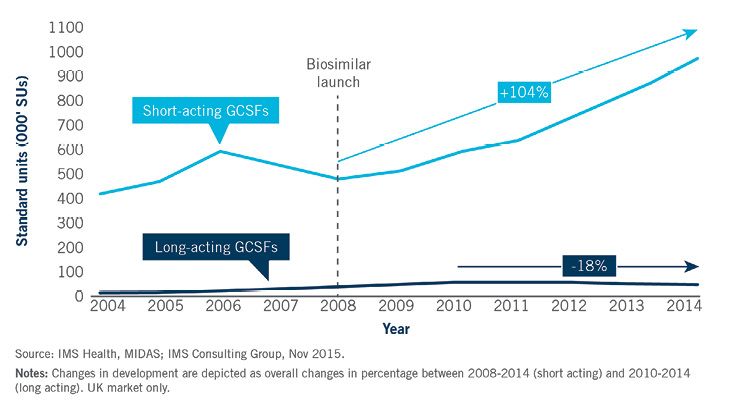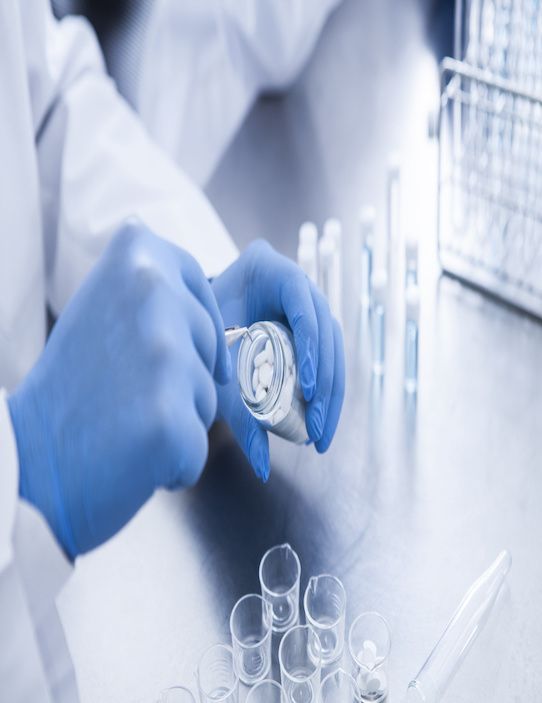Future look: The Impact of Biosimilars on Oncology
Marketing strategies will adjust with the advent of biosimilars
click to enlarge

Fig. 1. The introduction of the short-acting biosimilar filgrastim raised the overall filgrastim market in the UK. Source: IMS Consulting Group[/caption]
In 2016, no topic generated more interest
and attention from payers than oncology. A close second—biosimilars. Now, these points of payer focus are converging. As new oncolytic and supportive care biosimilars begin to emerge in 2017, the impact these products can make will be an important priority for health plans and manufacturers alike. [1]
What can we plan for and expect from biosimilars in oncology? Through our analysis of data on existing biosimilars, upcoming launches in oncology and supportive care, and proxies from other conditions showing how biosimilars have impacted therapy and sales, we will provide information to help plan for this uncharted territory.
Understanding payer expectations
US payers are seeing data that promise potentially dramatic cost reductions through the adoption of biosimilars. These data show combined overall savings in the US and Europe ranging from $56 to $110 billion through 2020. [2] Payer expectations on savings are high, so when it comes to oncology, biosimilars will become a core focus for future plans. Zarxio, a biosimilar version of filgrastim, has been on the market in the US since 2015, and biosimilar versions of the oncology therapies bevacizumab, trastuzumab, as well as supportive care therapy pegfilgrastim are under review by FDA. Also a Biologics License Application submission for rituximab is expected this year.
US-based payers are keenly monitoring the uptick of biosimilar use in Europe to anticipate what may happen in the United States. For instance, use of biosimilar filgrastim, which is used in chemotherapy patients for the treatment of infection and neutropenic fevers, rose more than 40% since 2009 and now outsells the originator in some countries, including the United Kingdom. [3]
Payers watching these products may also be considering the influence of policy. Between 2009 and 2014, overall use of filgrastim in the UK increased by 104% (Fig. 1). This is primarily due to a number of UK Strategic Health Authority guideline updates allowing for first-line use of the anti-infection medicine in cancer patients based on the availability of the filgrastim biosimilar, which made it possible to treat more patients in a more cost-effective manner.
In Europe, there is considerable variation in price across the drug class (originator as well as biosimilar) in different countries. For example, the observed price reduction of filgrastim in 2015 varied from 14% in France to 27% in Germany, and there was actually a 1% increase in the filgrastim price in Spain. [4] This significant variability makes it difficult to predict how prices in the US will be impacted. Zarxio, the US filgrastim biosimilar, launched with a 15% discount and, after a slow start, has surpassed the reference product in volume market share. [5]
Biosimilar uptake may not be quick
When considering speed of uptake, it should be noted that price and uptake are not well correlated. In a 2016 report, IMS Institute found that high biosimilar market share did not necessarily equate to the greatest price reductions in the European Economic Area. This finding was consistent across four classes of drugs, including epoetins, granulocyte colony-stimulating factor, human growth hormone and anti-tumor necrosis factor. [6]
This further reinforces what we saw with filgrastim in the United Kingdom—that guideline shifts were the primary trigger for uptake—and underscores that physician acceptance is essential. It is reasonable to expect that biosimilar use will increase significantly once physicians grow accustomed to them. Manufacturer-sponsored education initiatives will be important as individual physicians may not seek out information about biosimilars themselves; however, information from other sources, such as guidelines and regulatory bodies, may be seen as more impartial. [4]
Difficulties of biosimilar pricing
It is no secret that the general public, as well as politicians, are concerned about the rising cost of health care and have focused particularly on the rising cost of drugs. The public demand is for quality medications at lower prices. Biosimilars have the potential to meet this demand, but the topic of biosimilar pricing is complex and the path forward can be unclear.
Development costs are much higher for biosimilars than for conventional generics, due to more stringent requirements for regulatory approval. These costs range from $100 to $250 million compared with generics at $1 to $4 million. With higher development costs and active promotion resulting in a greater investment in patient support and marketing services, it’s not surprising that biosimilars are offering more modest cost savings than those achieved with generic products. While generic savings have ranged from 50% to 90%, anticipated savings with biosimilars might be just 15% to 30%. [7]
Stakeholders in the pharmaceutical marketplace
There are multiple stakeholders involved with the distribution of and payment for drugs. These stakeholders generate revenue in various and sometimes conflicting ways. It is important for biosimilar manufacturers to consider all of these stakeholders when setting prices.
Wholesalers, as an example, need to cover their operational costs and generate revenue on pharmaceutical transactions. They do this through on-invoice discounts, prompt-pay discounts, stocking fees (typically based on a percentage of the wholesale acquisition cost [WAC]), and other margins. As a result, wholesalers may have a disincentive to carry a lower WAC biosimilar, potentially creating a barrier to the manufacturer’s goal of wide distribution.
Payers, on the other hand, focus on net cost. Fewer rebates and discounts exist in many oncology-related conditions than other therapeutic areas, [8] and pharmacy directors tend to seek contracts that lower their net costs. Because pharmacy directors often use average sales price (ASP) or average wholesale price as a reference price, simply entering the market at a lower WAC may not be enough to establish a formulary position with the reference biologic. Additional discounts and rebates to reduce net cost may need to be considered. Also, call points beyond the pharmacy director, such as the negotiators of provider contracts, may have differing priorities within the plan and may warrant attention.
Complexities of reimbursement for oncology-based biosimilars
The majority of biologic drugs, including the oncolytic biosimilars under review by FDA, are administered by physicians and reimbursed under Medicare Part B or commercial insurance under the medical benefit. This means that they are purchased and administered by providers under a benefit that is not as tightly controlled as the pharmacy benefit.
Medical benefit reimbursement is typically based on ASP or average selling price. The ASP is a weighted average price net of all discounts and rebates, updated quarterly with a lag, and it often deteriorates over time as rebates and discounts increase. Many commercial payers follow the Medicare Part B structure, but some may choose to contract with providers for reimbursement based on other reference prices, such as WAC or average wholesale price (AWP).
The Centers for Medicare & Medicaid Services (CMS) finalized rules on biosimilar reimbursement specifying that all biosimilars to one reference product will be assigned a single Healthcare Common Procedure Coding System (HCPCS) code, and reimbursement will be based on a blended ASP of all included biosimilars plus 6% of the payment for the reference biologic product. [9] This policy was intended to create price competition, but biosimilar price reductions drive down the overall blended rate and reimbursement for all biosimilars. There may be unintended downstream consequences associated with this over time. These include physicians choosing a reference product with a greater dollar margin, reducing the potential profitability of biosimilars to a degree that deters manufacturers from developing them, and biosimilar manufacturers independently deciding to keep prices high to protect profit margins.
Biosimilars are likely to become a part of impending oncology management
Mandated coverage of oncology therapies creates payer management challenges. The extensive development of new drugs, increased availability of diagnostics, competition within cancer types, and advent of oncolytic biosimilars will drive plans to make difficult management decisions.
Management tools
Some payers are beginning to increase out-of-pocket responsibilities for patients under both the medical and pharmacy benefits in hopes of better controlling costs. The oral chemotherapy parity legislation has furthered this shift in oncology by requiring equal treatment of drugs under both benefits so as not to disadvantage oral drugs covered under the pharmacy benefit. [10] This increases the need for patient input in treatment decisions, and patients may be more likely to choose a lower-cost biologic option such as a biosimilar rather than a less expensive, and potentially less effective, therapy.
Bundled or episode-based payments reimburse providers at a prospectively set rate for a group of services during an episode of care, including reimbursement for pharmaceutical costs. An example of this is the CMS Oncology Care Model (OCM) pilot program, which utilizes bundled payments and currently includes approximately 190 practices. [11] The OCM program can be expanded to include commercial patients, and this new financial accountability may help shift oncologists toward less costly biosimilars.
Some private payers reward higher generic prescribing with a payment bonus incentive. This type of program could be extended to interchangeable biosimilars and would be based on the volume of biosimilar prescribed relative to the reference product.
Another cost-containment opportunity for commercial payers is the use of standardized clinical pathways to drive utilization to a preferred sequence of drugs. Payers may offer providers financial incentives to follow pathways such as higher reimbursement rates or care management fees. Biosimilar inclusion in a pathway could lead to lower costs, and the net savings can be shared between the provider and the health plan.
To demonstrate the value of biosimilars to payers, manufacturers will need to collect and communicate relevant data that helps facilitate the discussion on how cost containment, reduced acquisition cost, and higher cost sharing can lead to better utilization and outcomes.
Marketing considerations for the impact of oncolytic biosimilarsGiven payers’ expectations and the evolving oncolytic and supportive care biosimilar market, there are many factors that both originator and biosimilar manufacturers should consider.
Originator manufacturers
One consideration for originator manufacturers that will face biosimilar competition is setting the stage for reliability. Promoting a history of established efficacy and safety along with the benefits of a proven distribution channel with cost-of-switching implications may help sway payers and providers to stay with an originator manufacturer and slow down biosimilar uptake.
Another consideration is to refocus on brand loyalty programs, patient support programs, or wraparound services that support patients and providers in order to keep existing relationships strong. These are all elements that raise the cost of entry for a biosimilar and help differentiate originator brands.
Lastly, innovative contracting models based on outcomes, preferred status, or existing volume to build additional discounts and rebates are a potential strategy to blunt competition.
Biosimilar manufacturers
While biosimilar manufacturers should consider how originators might be shaping the market, there are a number of considerations for manufacturers before and during product launches.
A sustainable and healthy biosimilar market is important to help reduce costs and increase access to the best therapies, and payers need to understand that biosimilar manufacturers must remain profitable to continue development. For example, with 22% of revenue going to supply chains, and another 20% taken in by rebates, discounts, and fees from originator manufacturers, sustaining profit as a biosimilar with decreased pricing can prove difficult. [12]
Even before launch, manufacturers should collaborate with payers in an unbranded fashion on utilization management and other strategies to encourage physicians to adopt biosimilars. Using credible resources such as key opinion leaders to educate payers may also help to overcome slow uptake.
Working to establish interchangeability with FDA, or providing data to support substitution in hospitals or with health plans, may be imperative to eliminate potential hurdles to increased utilization and uptake. As 2nd, 3rd, or even 4th biosimilars to one reference product launch, the volume of a manufacturer’s portfolio within a plan may play a much larger role. These manufacturers will also likely need to launch with established interchangeability to the originator biologic and even proceeding biosimilars if possible. Multiple biosimilar entrants may lead to commoditization, making interchangeability important for success.
As audience needs around pricing vary greatly, it is important to consider all of the angles, by segmenting customers and distribution channels to create targeted messaging for each. Consider how some members of a payer organization are looking for a rebate, while others, such as those contracting with providers, may need a lower WAC. Biosimilar manufacturers bringing an additional biosimilar to one reference product may even choose to limit distribution to certain sites of care to differentiate itself from its predecessors.
Playing both sides
Lastly, there will be biologic manufacturers that see opportunities to invest in the biosimilar market. For these organizations, marketing can become more complicated as conflicting messages from field teams about the value of reference drugs versus biosimilar versions can create confusion among both providers and payers. Demonstrating a commitment to bringing new biologic therapies to a plan’s members while also investing in biosimilars to help them lower costs could be an avenue to balance the need for lower-priced and more accessible medications with the need for innovative biologic therapies. Combining this strategy with portfolio contracting that retains existing positions with biologics and expands share with biosimilars can certainly establish an entrenched position that will be difficult for competitors to challenge.
References
- Data on file. inVentiv Health Managed Markets, Saratoga Springs, NY. inVentiv Health Research and Insights, Newtown, PA.
- Friends of Cancer Research and the Duke-Margolis Center for Health Policy. “The Future of the US Biosimilars Market: Development, Education, and Utilization.” https://www.focr.org/sites/default/files/pdf/The%20Future%20of%20U.S.%20Biosimilars_0.pdf. Published October 18, 2016. Accessed March 8, 2017.
- Rifkin R, Cutler c, Gascon P, McCamish M. “Biosimilars in Oncology: Proceedings From a Roundtable Discussion, December 6, 2015, Orlando, Florida, in conjunction with the 57th ASH Annual Meeting.” The ASCO Post. http://www.ascopost.com/issues/november-10-2016-supplement/biosimilars-in-oncology/. Published November 10, 2016. Accessed March 8, 2017.
- IMS Institute for Healthcare Informatics. “Delivering on the Potential of Biosimilar Medicines: The Role of Functioning Competitive Markets.” http://www.imshealth.com/files/web/IMSH%20Institute/Healthcare%20Briefs/Documents/IMS_Institute_Biosimilar_Brief_March_2016.pdf. Published March 2016. Accessed March 8, 2017.
- Stanton, D. “Biosimilars land in the US as Sandoz launches Zarxio.” BioPharma-Reporter.com. http://www.biopharma-reporter.com/Markets-Regulations/Biosimilars-land-in-the-US-as-Sandoz-launches-Zarxio. Published September 3, 2015. Accessed March 14, 2017.
- IMS Health. “The impact of biosimilar competition on price, volume and market share.” Published June 2016. Report available at the European Commission website: http://ec.europa.eu/growth/tools-databases/newsroom/cf/itemdetail.cfm?item_id=8854. Updated October 24, 2016. Accessed March 8, 2017.
- “Comparison of biosimilars and generic drugs.” Managed Health Care Connect. http://www.managedhealthcareconnect.com/articles/comparison-biosimilars-and-generic-drugs. Published October 16, 2013. Accessed March 8, 2017.
- MagellanRx Management. “Medical Pharmacy Trend Report; 2015, 6th ed.” https://www1.magellanrx.com/media/409913/2015trendreport_mayfinal.pdf. Accessed March 17, 2017.
- “Patient Protection and Affordable Care Act.” Sec 3139. 2010. US Government Printing Office. https://www.gpo.gov/fdsys/pkg/BILLS-111hr3590enr/html/BILLS-111hr3590enr.htm. Accessed March 8, 2017.
- “Oral oncology parity laws.” State Patients Equal Access Coalition. http://speac.myeloma.org/wp-content/uploads/2014/08/OralOncologyParityOnePageFactSheet_August2014.pdf. Accessed March 8, 2017.
- Centers for Medicare & Medicaid Services. “Oncology Care Model.” https://innovation.cms.gov/initiatives/oncology-care/. Updated March 16, 2017. Accessed March 16, 2017.
- Vandervelde A, Blalock E. “The pharmaceutical supply chain: gross drug expenditures realized by stakeholders.” Berkley Research Group. http://www.thinkbrg.com/media/publication/863_Vandervelde_PhRMA-January-2017_WEB-FINAL.pdf. Published 2017. Accessed March 8, 2017.
ABOUT THE AUTHORS


At InVentiv Health, Ben Curtis is EVP, Director of Integrated Strategic and Creative Services, and Katherine Seay is VP, Managed Markets Content Expert.
Save
Save

Newron, Myung In Pharm Form Partnership Centered Around Treating Schizophrenia in South Korea
January 14th 2025The license agreement will feature an upcoming Phase III trial and—depending on results—the development, manufacturing, and commercialization of evenamide as a potential treatment option.